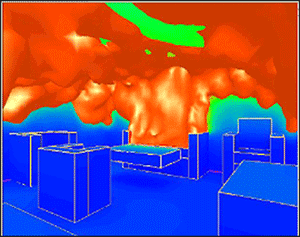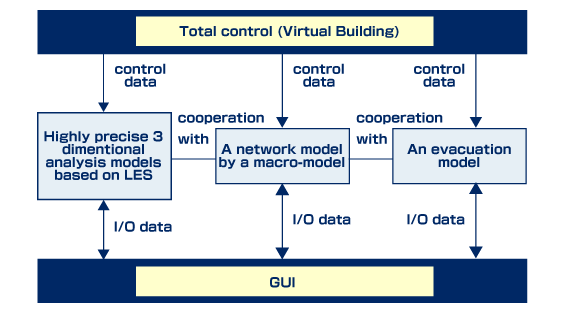Prof. Shinsuke Kato,
Institute of Industrial Science, The University of Tokyo

Background
The number of large-scale subterranean complexes and skyscrapers has rapidly increased in recent years. These facilities exhibit complex airflow paths, many of which affect areas of human activity and evacuation routes. There is an increasing risk that the varied operational conditions of disaster prevention systems may themselves exacerbate a major disaster in the event of a fire or terrorism involving biochemical weapons, because of the complexity of the nonlinear airflow paths. In order to prevent or minimize such a catastrophe, disaster prevention systems should be appropriately installed with due consideration given to their reliability and robustness. In this regard, it is essential to develop a simulator that affords precise prediction and evaluation of the environment and safety.
Development Objectives
The simulator will be developed by combining (1) the effects of correct and faulty operation of disaster prevention systems related to airflow control in a space involving complex airflow paths including human activity areas, (2) changes in evacuation guidance systems during a fire (shutoff of paths and guidance to evacuation routes), and (3) changes in building conditions during a fire. The simulator will be coupled with a safety performance evaluation system or multipurpose optimization system to dramatically improve the reliability and robustness of the disaster prevention design of buildings.
Development Content
(1) Construction of a virtual building database system
The simulation in this study is performed using multiple modules, since physical models are used to describe airflow in an emergency situation, the transport of various hazardous materials by the airflow, growth of the fire, the influence of extinguishing operations, and evacuation activity in subterranean complexes and buildings. A database to describe subterranean complexes and buildings, which is called a virtual building, is subjected to modification using the modules’ input and output data. After developing a virtual building, an efficient design system for the environment and safety will be completed by creating interfaces with various existing building energy-managing systems (BEMS) as well as with simulated models of building air conditioning (such as HVAC-Simu), computational fluid dynamics (CFD), fire, and evacuation.
(2) Research and development of a simulator, as an anti-terrorism measure, for the advection and diffusion of health hazards in areas of human activity, including airflow paths that support such activity
A simulator of health-hazard advection and diffusion will be developed by combining a high-precision three-dimensional analytical model based on large-eddy simulation (LES) and a network model based on one-dimensional flow.
(3) Research and development of a simulator, as an anti-fire measure, for the advection and diffusion of smoke and for the spread of fire in areas of human activity including airflow paths that support such activity
A simulator of smoke advection and diffusion during a fire will be developed by combining a high-precision three-dimensional analytical model based on LES and a network model based on one-dimensional flow.
(4) Research and development of a system for the optimum design of emergency evacuation guidance
A migration model associated with the physical variables of a macro model will be developed in consideration of the effect of fire radiation on the behavior of evacuees. A model for determining optimum evacuation routes in conjunction with an optimum method will also be developed.





